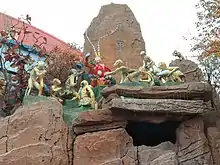Mount Huaguo
Mount Huaguo (traditional Chinese: 花果山; pinyin: Huāguǒ Shān; Wade–Giles: Hua1kuo3 Shan1; Japanese: Kakazan; Vietnamese: Hoa Quả Sơn) or Flowers and Fruit Mountain, is a major area featured in the novel Journey to the West. It is also the name of a popular tourist destination based on the novel.

Journey to the West
In the novel, this mountain is located in the country of Aolai (傲來) in the Eastern Continent of Superior Deity (simplified Chinese: 东胜神州; traditional Chinese: 東勝神州; pinyin: Dōng Shèngshenzhōu; Wade–Giles: Tung1Sheng4shen1Chou1), also known in Anthony C. Yu's translation as the "Pūrvavideha Continent". It is known as the birthplace of Sun Wukong (the Monkey King), a protagonist of the novel. The large mountain has many demons and monkeys in its population and contains many hidden areas, such as the Shuilian Cave. After Sun Wukong bravely rushes through a large waterfall and into this cave, every individual in the mountain acknowledges him as their king.
After Sun Wukong becomes king, this mountain becomes exceedingly civilized and well-trained for various future conflicts, such as war. This can be seen in the fact that Sun Wukong often left this mountain for various reasons, including his eventual task of protecting the Tang monk Tang Sanzang on his journey to India. Due to the natural and civilized ways of this mountain set by Sun Wukong, this mountain continues to thrive even after 500 years of conflict.
Location
Mount Huaguo is located in Yuntai, Jiangsu, seven kilometers southeast of Lianyungang City.[1] It lies 625 meters above sea level and covers an area of 84.3 square kilometers, with 136 peaks. The area is a popular tourist attraction as a result of its appearance in the novel Journey to the West.[2]
Tourism
Mount Huaguo is a popular tourist attraction, especially because of its role in the novel Journey to the West. It has over 100 scenic spots[2] and thousands of visitors every year. Since the novel is very influential and popular in China, the mountain has many statues based on its heroes, such as a sculpture of the head of Sun Wukong (the Monkey King), a protagonist of the novel, who was also said to be born on the mountain. Near the entrance stand sculptures of the four main characters, along with 109 stone monkeys welcoming visitors as they enter and six stone lions guarding the mountain. Other attractions related to Sun Wukong include the Monkey Stone, Water Curtain Cave, Sanyuan Palace, Yuvu Peak, South Gate of Heaven, etc.
Monkey Stone
The "Monkey Stone" resembles a monkey from a distance. Because of this, people like to relate the stone with the Sun Wukong, who rules and protects his home just as the stone monkey seems to protect Mount Huaguo.[3]
Water Curtain Cave
Water Curtain Cave, or Shuilian Cave (simplified Chinese: 水帘洞; traditional Chinese: 水簾洞; pinyin: Shuǐlián Dòng; Wade–Giles: Shui3lien2tung4), is a natural waterfall over a cave that was formed by a ground fissure. There are many ancient carvings in front of the cave, with letters written by emperors from different dynasties. For example, "印心石屋" was written by the Daoguang Emperor during the Qing dynasty. Inside, there are tunnels leading to a platform inside the cave. There is a spring inside called Lingquan Spring; it is not big, but it is always full of water, even when there is a drought. It is said that the spring can lead you to the Dragon King's Palace.[2]
The cave is featured within the novel Journey to the West, written in the Ming Dynasty. Very early on, Sun Wukong becomes the king of this cave, and it is generally used for all the monkeys to train within and generally rest. Before such an event, Wukong, with his bravery, nominated himself to be the monkey that would rush through the Mount Huaguo's great waterfall in order to see what was behind it. He discovered
- Emerald moss piled up in heaps of blue,
- White clouds like drifting jade,
- While the light flickered among wisps of coloured mist.
- A quiet house with peaceful windows,
- Flowers growing on the smooth bench;
- Dragon pearls hanging in niches,
- Exotic blooms all around.
- Traces of fire beside the stove,
- Scraps of food in the vessels by the table.
- Adorable stone chairs and beds,
- Even better stone plates and bowls.
- One or two tall bamboos,
- Three or four sprigs of plum blossom,
- A few pines that always attract rain,
- All just like a real home.
Following this, Wukong
- took a good, long look and then scampered to the middle of the bridge, from where he noticed a stone tablet. On the tablet had been carved in big square letters: HAPPY LAND OF THE MOUNTAIN OF FLOWERS AND FRUIT, CAVE HEAVEN OF THE WATER CURTAIN (Chinese: 花果山福地、水帘洞洞天). The stone monkey was beside himself with glee. He rushed away, shut his eyes, crouched, and leapt back through the waterfall.
After many points following this, Sun Wukong returned to the Water Curtain Cave for miscellaneous reasons, either while returning from his celestial master, or because of an issue with his enlightened master, Sanzang.
San Yuan Palace
San Yuan Palace is the biggest building in Mount Huaguo, and one of the most ancient. It was initially built during the Tang dynasty. It contains three statues that represent the three gods of Heaven, Earth, and Water.[2]
References
- 花果山风景区 (in Chinese). 花果山风景区. Archived from the original on 28 January 2013. Retrieved 15 August 2013.
- "Huaguoshan Mountain". ForeignerCN.com. 2009. Retrieved 15 August 2013.
- "Mount Huaguo". Cultural China. Archived from the original on 12 May 2013. Retrieved 15 August 2013.